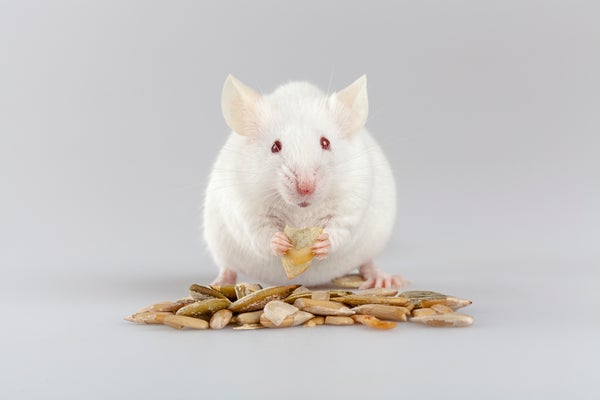If you give a mouse a beer, he’s going to ask for a cookie—and another, and another. If you give a person enough beer, she might find herself wolfing down a plate of greasy nachos. But why does binge drinking make us binge eat as well? The reason may lie not in the stomach but in the brain, recent research suggests. A study published today in Nature Communications found alcohol activated brain cells that control hunger, sending drunk mice scampering for snacks even when they were not really hungry.
Researchers from The Francis Crick Institute Mill Hill Laboratory in London got mice drunk, then tagged and recorded the electrical activity in brain cells linked to hunger, uncovering a neural mechanism that could explain why the animals ate significantly more after binge-drinking sessions even though their bodies did not need the calories.
Although hunger pangs in our stomach usually alert us that it is time to eat, the impulse to consume food originates in our brains, and brain cells located in the hypothalamus called agouti-related protein (AgRP) neurons play a key role in controlling hunger. A previous study showed that when AgRP neurons are activated, mice almost immediately seek out food and start eating, even if their stomachs are full. By contrast, when AgRP neurons are deactivated, hungry mice will not eat. AgRP neurons play a similar role in human hunger: Under natural conditions they are activated when our bodies need calories, signaling to us that we should find food. Something different happens, however, when alcohol is involved. Although alcohol is second only to fat in caloric density, previous studies have shown drinking causes humans to eat more, a paradox that made lead authors Craig Blomeley and Sarah Cains and colleagues wonder whether the brain could be to blame.
On supporting science journalism
If you're enjoying this article, consider supporting our award-winning journalism by subscribing. By purchasing a subscription you are helping to ensure the future of impactful stories about the discoveries and ideas shaping our world today.
The neuroscientists first set out to confirm that consuming alcohol compels mice to eat more. They injected alcohol into the abdomens of male and female mice (housed alone to control for social factors) once a day for three days, mimicking an “alcohol weekend.” Each injection was the mouse-equivalent of roughly two bottles of wine, or six to eight British pints—what Blomeley calls “a proper binge session.” Over the three-day period intoxicated mice of both sexes ate significantly more than sober mice—a difference that was particularly pronounced on day two of the binge.
To investigate whether AgRP neurons are partly responsible for this behavior, the researchers sliced mouse brains into thin sections and tagged the AgRP neurons (kept alive with a nutrient solution) so calcium in the cells would glow green under a microscope—a proxy for cell activity. When the researchers bathed the sections in different concentrations of alcohol, they found that more alcohol caused calcium levels to increase. Next, the researchers exposed the neurons to different concentrations of alcohol and used probes to record the cells’ electrical activity. They found that alcohol exposure alters calcium exchange in the cells, which causes AgRP neurons to fire more frequently and easily. Activity in AgRP neurons returned to normal after the alcohol was flushed away, indicating the cells were not permanently altered.
Together, these results suggest alcohol directly activates AgRP neurons in the brain, which is what keeps mice munching away even when they do not need to eat. But what does this tell us about about our own alcohol-related eating habits? Blomeley and Cains point out that whereas we cannot definitely say whether the mechanism works the same way in humans, this brain circuitry is evolutionarily ancient and has been highly conserved across mammal species. “I don't doubt that AgRP neurons are activated in humans,” Cains says, “and that's why you see this effect.” Understanding the relationship between alcohol consumption and overeating is particularly important within the context of obesity, she adds. Although obesity is on the rise in many developed countries and alcohol intake has also increased, the two are often studied separately. “This study ties them together,” she says. The work “shows that if you have an increased alcohol intake, then you're going to, as a result of that through the effect of alcohol on your brain, have an elevated level of food intake.”
Scott Sternson, a neuroscientist at Howard Hughes Medical Institute who was not involved in the research, says the work is the first to show how alcohol activates AgRP neurons. He considers the study “an interesting and unexpected starting point” for further research, but questions whether the high alcohol levels used in the study are consistent with the kind of drinking often associated with overeating in humans. Compared with that of mice, human behavior is complex and other environmental or social factors may influence food intake while drinking, he adds.
David Kareken and Robert Considine, neuroscientists at Indiana University, point out that although several human studies have shown drinking alcohol before a meal increases food intake, the reasons have remained unclear. They add these “elegant animal experiments” involved manipulations that could not be done in humans, and were needed to better understand how alcohol affects hunger. “This work sheds a lot of light on how that pre-meal aperitif might push us toward gaining a few extra pounds,” they wrote in an e-mail.
Building on this work, Cains is interested in why alcohol seems to make us crave certain foods, such as those greasy nachos. “I've never had a drink and then really fancied a salad,” she says, “It would be interesting to see if [intoxicated] mice have a preference for a high-fat diet.”
